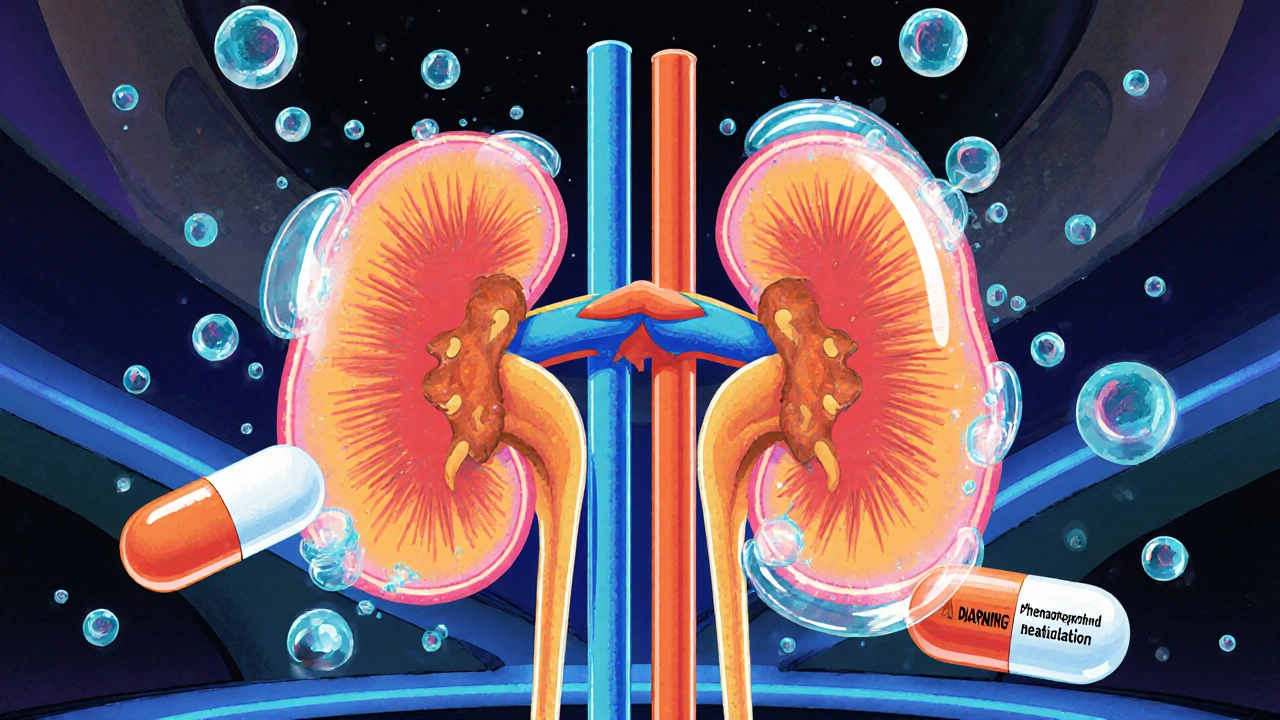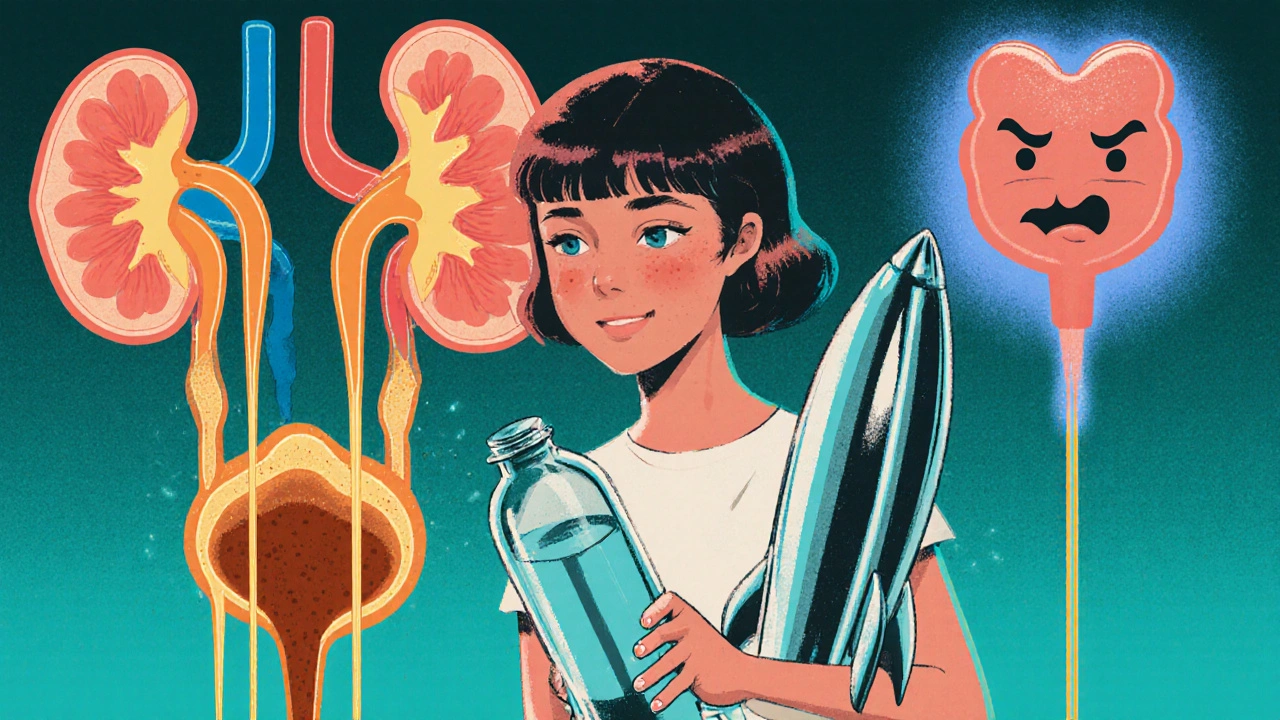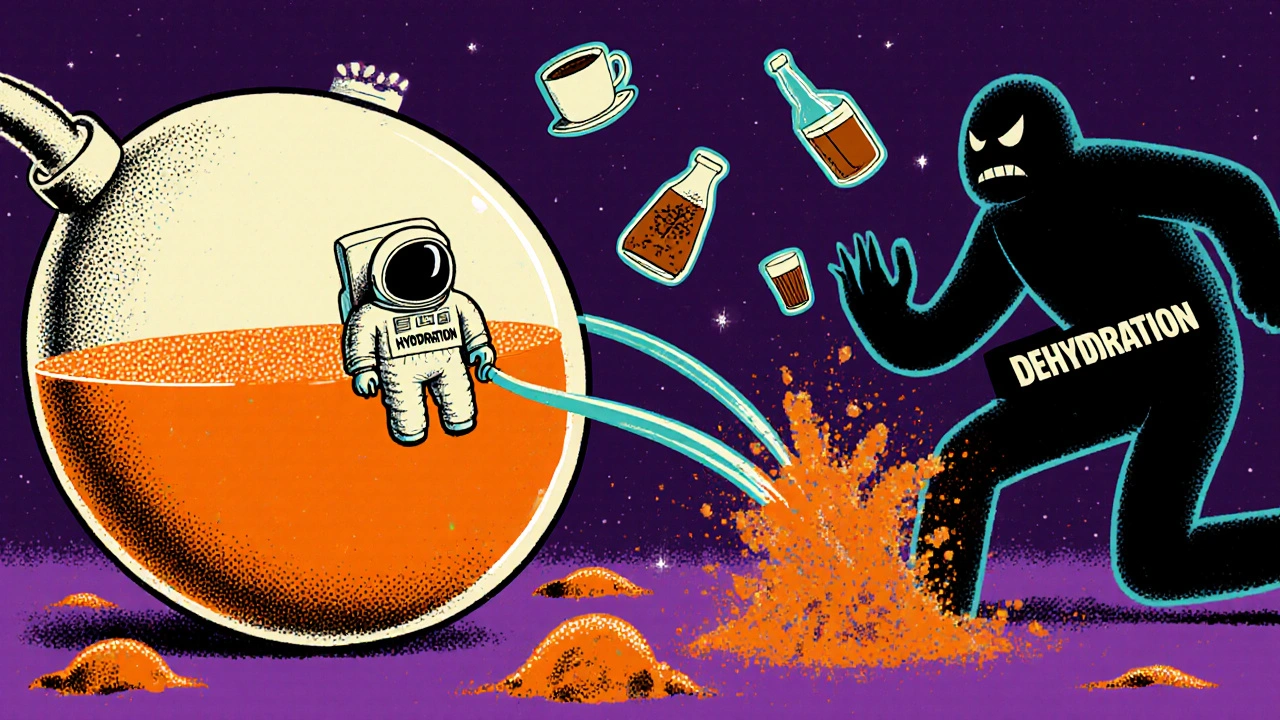Why Proper Hydration Is Critical When Taking Phenazopyridine
 Oct, 30 2025
Oct, 30 2025
When you’re dealing with a urinary tract infection (UTI), phenazopyridine can bring quick relief from burning, pain, and urgency. But if you’re not drinking enough water while taking it, you could be making things worse - not better. This isn’t just a general health tip. It’s a medical necessity tied directly to how phenazopyridine works in your body.
What phenazopyridine does - and doesn’t do
Phenazopyridine, sold under brand names like Azo Standard or Uristat, is a urinary analgesic. It doesn’t kill bacteria. It doesn’t cure your infection. It only masks the pain. Think of it like putting a bandage on a broken bone - it helps you feel better while the real healing happens elsewhere, usually with antibiotics.
But here’s the catch: phenazopyridine gets filtered out by your kidneys and ends up in your urine. That’s why your urine turns bright orange or red. It’s harmless, but it’s also a sign that the drug is concentrated in your bladder. If you’re not drinking enough water, that concentration gets even higher.
What happens when you don’t drink enough water
Low fluid intake while on phenazopyridine can lead to three serious issues:
- Increased risk of kidney irritation - The drug’s metabolites can become too concentrated in your urine, irritating the lining of your kidneys and ureters. This isn’t just uncomfortable - it can cause actual damage over time.
- Slower recovery - Dehydration makes it harder for your body to flush out bacteria. Even if you’re on antibiotics, not drinking water means the infection lingers longer.
- Higher chance of side effects - Nausea, dizziness, and headaches are common with phenazopyridine. Dehydration makes these worse. In rare cases, it can even trigger hemolytic anemia in people with G6PD deficiency - a condition that’s often undiagnosed until something like this happens.
A 2023 study in the Journal of Urological Nursing followed 187 patients taking phenazopyridine for acute UTIs. Those who drank less than 1.5 liters of water per day were 3.2 times more likely to report severe abdominal discomfort and prolonged symptoms than those who drank 2.5 liters or more.
How much water should you actually drink?
You don’t need to chug gallons. But you do need to be intentional. The standard advice is:
- Drink at least 2 liters (about 8 cups) of water per day while taking phenazopyridine.
- Start your day with a full glass of water before taking your first dose.
- Keep a water bottle with you and sip throughout the day - don’t wait until you’re thirsty.
- Avoid alcohol, caffeine, and sugary drinks. They dehydrate you and can irritate your bladder even more.
Here’s a simple rule: If your urine is dark yellow or amber, you’re not drinking enough. Aim for pale yellow - like lemonade, not tea.

What if you can’t drink that much?
Sometimes, people struggle with hydration because of mobility issues, incontinence fears, or medical conditions like heart failure. If that’s you, talk to your doctor. There are alternatives:
- Your doctor might reduce your phenazopyridine dose or shorten the treatment time.
- You might switch to a different pain reliever that doesn’t require high fluid intake.
- In some cases, IV fluids in a clinic can help if dehydration is severe.
Don’t assume you have to suffer through side effects. There’s always a safer way - you just need to speak up.
Signs you’re not hydrated enough
Watch for these red flags:
- Urine that’s dark yellow or brown
- Dry mouth or cracked lips
- Frequent dizziness, especially when standing
- Decreased urination (less than 3-4 times a day)
- Unusual fatigue or confusion
If you notice any of these, increase your water intake immediately. If symptoms don’t improve within a few hours, call your doctor. Dehydration can escalate quickly when you’re on medication.
What about other fluids?
Water is the best option. But if you hate plain water, here’s what’s okay:
- Herbal teas (caffeine-free, like chamomile or peppermint)
- Broth or clear soups
- Coconut water (low sugar, no additives)
- Infused water with lemon, cucumber, or mint
Avoid:
- Soda (even diet - artificial sweeteners can irritate the bladder)
- Energy drinks (high caffeine, high sugar)
- Alcohol (dehydrates you and worsens UTI symptoms)
- Excessive coffee (more than one cup a day can be a problem)

What to do after you finish phenazopyridine
Even after your symptoms fade, keep drinking water for another 24-48 hours. Why? Because the drug can still be in your system, and your bladder needs time to fully flush out any remaining irritants. Plus, staying hydrated helps prevent another UTI from coming back.
Many people stop drinking water as soon as they feel better. That’s when infections often return. Hydration isn’t just for when you’re in pain - it’s part of your long-term defense.
Real-life scenario: What went wrong
Sarah, 58, took phenazopyridine for a UTI and felt better in two days. She stopped drinking water because she didn’t want to keep running to the bathroom. Within 36 hours, she was back in the ER with kidney pain and fever. Turns out, the infection had spread. Her urine was thick and dark orange - a sign of concentrated phenazopyridine and bacteria.
She didn’t know hydration was part of the treatment. Her doctor told her: “You didn’t just treat the pain. You ignored the system that needed to heal.”
She now keeps a water bottle on her nightstand and sets phone reminders. She says it’s the simplest thing that changed everything.
Final reminder
Phenazopyridine gives you quick relief - but it’s not a cure. Water is what actually heals you. Drinking enough isn’t optional. It’s the most important part of your treatment plan.
If you’re taking this medication, treat hydration like you treat your pills - as non-negotiable. Your kidneys will thank you. Your recovery will be faster. And you’ll avoid the pain you were trying to escape in the first place.
Can phenazopyridine cause kidney damage?
Yes, if taken without enough fluids. Phenazopyridine is processed by the kidneys, and high concentrations in urine can irritate kidney tissue over time. This risk increases with dehydration, long-term use, or pre-existing kidney conditions. Always drink at least 2 liters of water daily while taking it.
Why does phenazopyridine turn urine orange?
Phenazopyridine breaks down into compounds that are orange-red when excreted. This is normal and harmless, but it can stain clothing and contact lenses. Drinking plenty of water dilutes the color and helps flush the drug out faster.
How long should I take phenazopyridine?
Usually no longer than 2 days unless directed by a doctor. It’s meant for short-term symptom relief while antibiotics work. Taking it longer without medical supervision increases side effect risks, including liver and kidney stress.
Can I take phenazopyridine with antibiotics?
Yes, it’s common to take both together. Phenazopyridine eases pain while antibiotics fight the infection. But you still need to drink plenty of water - the combination puts more strain on your kidneys if you’re dehydrated.
Is it safe to drink alcohol while on phenazopyridine?
No. Alcohol dehydrates you, which increases the risk of kidney irritation from phenazopyridine. It also worsens UTI symptoms like burning and urgency. Avoid alcohol completely while taking this medication.
Geoff Colbourne
October 30, 2025 AT 13:37Bro, I took this stuff last month and thought the orange pee was some kind of alien signal. Turned out I was dehydrated and felt like I was being peed on from the inside. Water fixed it. No joke. Drink more water, stop being a robot.
Daniel Taibleson
October 31, 2025 AT 18:16While the article presents a clinically sound rationale for adequate hydration during phenazopyridine therapy, it is worth noting that individual fluid requirements vary based on body mass, ambient temperature, and renal function. A one-size-fits-all recommendation of 2 liters may not be appropriate for all populations, particularly those with comorbid cardiac or renal conditions. Clinical judgment remains paramount.
Jamie Gassman
November 1, 2025 AT 08:55Let me tell you something the pharmaceutical industry doesn’t want you to know. Phenazopyridine isn’t just a painkiller-it’s a trap. They know you’ll drink less water because you’re afraid of the bathroom. They know you’ll ignore the orange pee because it’s ‘harmless.’ They profit from your ignorance. This drug is designed to keep you dependent. And now they’re selling you water like it’s medicine. Wake up. This is all a scheme. They even made the urine color so you think it’s working. It’s not. It’s just poison in a pretty bottle.
Julisa Theodore
November 2, 2025 AT 06:57Water is the new holy water. We used to pray for healing, now we chug Gatorade and call it medicine. Phenazopyridine is just the latest cult leader in the church of Big Pharma. I don’t need a doctor to tell me to drink water-I need a therapist to tell me why I’m so desperate to follow rules written by people who’ve never had a UTI.
Lenard Trevino
November 2, 2025 AT 08:22Okay so I’m 62 and I’ve had three UTIs in the last year and I swear I didn’t think hydration was part of the treatment until my nurse yelled at me during a follow-up. I thought water was just for people who don’t like coffee. Turns out my kidneys were basically screaming at me like a toddler who missed naptime. I started carrying a 32oz bottle everywhere-bed, couch, car, even the damn toilet. Now I’m not just surviving, I’m thriving. I even made a playlist called ‘Hydration Hymns’-it’s just nature sounds and me saying ‘drink water’ on loop. My dog now brings me a glass. I’m not kidding. That dog knows more about my kidneys than my ex did.
Paul Maxben
November 4, 2025 AT 07:54so like i took this stuff and my pee looked like a sunset and i thought it was cool until i passed out in the bathroom. my wife called 911. turns out i drank like 2 cups of water all day. they gave me iv fluids and i felt like a new man. dont be me. drink water. its not that hard. also stop drinking soda. its evil. and also coffee. and also wine. just drink water. please.
Molly Britt
November 4, 2025 AT 16:41They’re watching your urine color. That’s how they track compliance. Orange = good. Clear = suspicious. They know if you’re drinking. Don’t fall for it.
Nick Cd
November 5, 2025 AT 12:09MY WIFE SAID I WASN’T DRINKING ENOUGH AND I THOUGHT SHE WAS JUST BEING CONTROL FREAK BUT THEN I GOT A FEVER AND THEY PUT ME IN THE HOSPITAL AND THE DOCTOR SAID MY KIDNEYS LOOKED LIKE THEY’D BEEN TAKEN TO A WASHING MACHINE AND I WASN’T EVEN DRINKING WATER I WAS JUST DRINKING TEA AND I THOUGHT THAT WAS ENOUGH BUT IT WASN’T AND NOW I’M ON A WATER SCHEDULE AND I HAVE A PHONE APP THAT BUZZES AND I EVEN SET A REMINDER FOR WHEN I GO TO THE BATHROOM TO DRINK MORE WATER AFTER AND I’M NOT KIDDING I’M A NEW MAN AND I JUST WANT EVERYONE TO KNOW THAT IF YOU’RE TAKING PHENAZOPYRIDINE AND YOU’RE NOT DRINKING WATER YOU’RE NOT JUST STUPID YOU’RE ENDANGERING YOURSELF AND I’M NOT MAD I’M JUST DISAPPOINTED